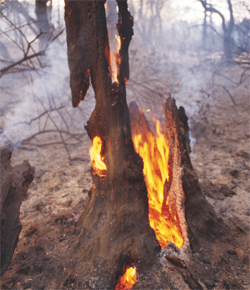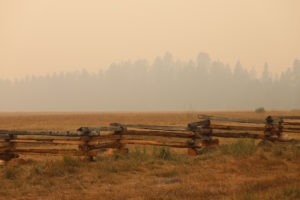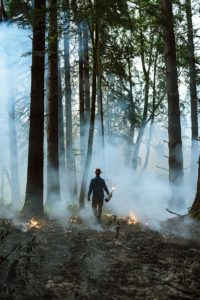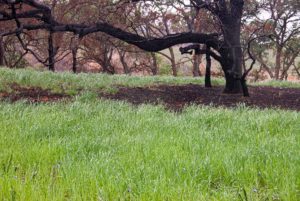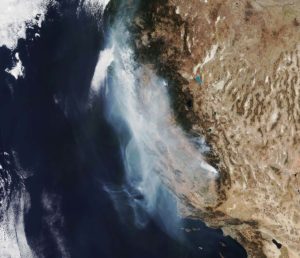On a clear January day in 2005, I took a walk up from my house on the east slope of Inverness Ridge to the trail that runs south from Mount Vision in Point Reyes National Seashore to Drakes View Drive and the Paradise Ranch Estates area. At the crest of the hill, in every direction, young bishop pines, their needles glistening in the sun, filled the view. The tallest were 15 feet or more, and they were packed together, needle to needle, forming a dense, almost impenetrable, living wall. In mid-October 1995, the same walk had taken me through a ghostly landscape of ash and the stumps of once-mighty trees. I was witnessing a miracle of transition and change—the regeneration of my sanctuary, the bishop pine forest of Inverness Ridge.
The scene took me back to an experience more than 30 years ago on the five acres where I now live. I had recently bought this piece of wilderness forest land and decided to host the UC Berkeley architecture class I was teaching on “Making a Place in the Country” here. The first assignment was to decide collectively how to design and build a structure that would meet our needs for food, water, sanitation, and energy, while impacting the land as little as possible. The first structure we built was a 16-by-24-foot meeting space we fondly dubbed “the Ark,” after the original Maybeck building that had housed the Berkeley architecture school until its move into an ugly concrete tower in 1964.
The group debated about the best site to erect the building so we wouldn’t have to remove any big trees. In the end, we selected a site that required the removal of several very small bishop pines. But several students—in the Berkeley fashion of the time—staged a “sit-down strike” to defend the young trees, proclaiming it was immoral to destroy any trees, no matter how small. We argued the issue for some hours before finally agreeing that inhabiting a forest did not have to mean destroying it. The kind of design for living we were experimenting with required a mutually beneficial adaptation and coevolution of forest and humans. What we weren’t aware of at the time was how a forest of a relatively fast-growing and short-lived species quite regularly changes and renews itself.
Fast-forward almost 25 years. On the afternoon of October 3, 1995, I got a call at my office in Sausalito from a friend in Bolinas who said there was thick smoke overhead from a fire up in Inverness. He offered to drive me up to my house in his big 4×4 truck. Soon thereafter, we were heading up north on Highway 1. From the road we could see the thick plume of smoke along the top of the ridge. At the Inverness turnoff we were stopped by a Highway Patrol roadblock. There were fire crews parked at the intersection trying to make radio contact with units fighting the fire. My friend talked his way through, saying he was a volunteer fireman. We headed up the hill to my house. The smell of smoke became stronger; looking up toward Mount Vision, we saw dense smoke and flashes of flame.
Soon after we got to my house, my son showed up. No one else was around. We took a hose and wet down the roof. I called a friend in another part of town; he told me our hill had been evacuated hours earlier. By then it was dark. We heard a sheriff’s car approaching and ordering everyone to evacuate. I wasn’t going to leave my sanctuary, at least not yet. We headed up to the hot tub hidden from the house, taking along a bottle of my favorite single malt scotch. We heard the sheriff’s car in the driveway, saw flashlights, heard men talking and then drive away.
From the hot tub, we had a clear view of Mount Vision, a 45 minute hike from my house, maybe a mile and a half northwest as the crow flies. One by one, the bushy-needled crowns of the big pines on the ridge popped into flame like wooden matches. We sat in the hot water, transfixed by the awesome power of the wildfire. We heard no sound except the fierce explosions of trees bursting into flame. There was a northerly breeze and in the 45 minutes we sat silently sipping scotch in the hot tub, the fire had moved quite a distance south along the ridge, the flames moving more slowly in our direction down the eastern slope. We figured the fire would have to leap a fire road about a half mile west of us before crossing the drainage and moving towards us. The upward draft of the ridge fire slowed the downhill movement of the flames; and the moist, dense bay trees on that slope wouldn’t burn as quickly as the dry needles and shaggy bark of the pines above.
The scotch bottle was empty. Our minds numbed by the spectacle, our bodies limp from the warm water, we went into the house for an uneasy sleep. Sometime during the night, I heard men shouting and went outside. There were two fire trucks idling in the driveway with five or six firefighters inside. They were from Kensington in the East Bay. The chief looked me over. “Didn’t the sheriff tell you to leave?” “They never came here,” I lied. The chief told me, “The fire’s moving mostly south but it could easily come this way, and we need to keep it from moving down the hill toward the town. There are other units up at the houses on the Nature Conservancy land. You can stay for now, but if we tell you to leave, you’ll follow my orders. Have you got a place for my men to sleep?” I smiled and took them to the Ark, our old class project which had since become a popular bed-and-breakfast cottage.
In the morning, the chief asked me to show him around the property he might have to defend. I took him through our rambling house and I showed him our 10,000-gallon concrete water tank with its own hydrant along with our 15,000 gallon-concrete-lined fish pond. The chief nodded approvingly. “You’re in good shape. We’ll hope for the best.”
I walked up the road with the chief and my son into the Bishop Pine Preserve, a 600-acre watershed that had been donated to the Nature Conservancy by an English painter, Gordon Onslow Ford, who still lived on the preserve together with fellow artists J.B. Blunk and John Anderson, to whom he had granted homesites.
Department of Corrections fire crews were busy cutting trees along the road through the preserve to widen it for big equipment that was arriving later that day. Ford’s home overlooked a deep valley and a hill with magnificent stands of twisted old pines. My son had often taken me down secret trails through this unique fairyland of sword ferns, mosses, and pines. Because Pinus muricata has no value as lumber, this forest had never been logged.
The Fire Command had decided to make Ford’s home their command center for our sector. Ford, a recluse, seemed confused and upset by all the activity. I thought of his talk many years earlier, at the dedication of the preserve, which had made a deep impression on me. Referring to his paintings—abstractions of the carbon molecule in points, lines, and circles—he spoke at length of “carbon consciousness.” I thought to myself, “We may all get to experience carbon consciousness pretty soon now.” But for the time being we were in no immediate danger, as the prevailing wind kept pushing the fire south, away from us.
Wednesday was a quiet day in our sector as the fire raced south into the park, jumping the Limantour Road toward Mount Wittenberg, the highest point in the area. It also roared into Paradise Ranch Estates, a housing development near the top of the ridge, destroying many of the homes there. I walked north along the Inverness Utility District fire road, where California Conservation crews were cutting firebreaks to keep the fire from working its way down towards us and the town of Inverness below. Bulldozers ripped through a steep slope of sword ferns, exposing the three-foot-solid mat of roots that makes these dense communities of native ferns an ideal form of natural erosion control.
On Thursday some friends showed up with rented equipment to cut a firebreak. Ken, a master builder for the Zen Center for many years, had experienced the Marble Cone fire near Big Sur which had almost destroyed the Zen monastery at Tassajara. He recommended that we clear the underbrush and small trees to the south and west of the house. If fire were to come, it would be from that direction. By now, there were more than 3,000 firefighters on the line up the hill, lots of bulldozers cutting firebreaks, and a number of helicopters making the five-minute round-trip from the ridge to Tomales Bay with their 3,000-gallon buckets. Never had the thumping whine of helicopters sounded so sweet.
- The Vision Fire burned hottest in the bishop pine forest,torching mature trees and depositing a rich layer of ash that willnourish the newly-released pine seeds. Photo by Richard Blair.
On Friday morning, the chief woke us early. “The fire is headed this way. You’d better pack up and get ready to leave.” Until then, we had been having a shared high adventure. Now, for the first time since that first night of the fire, I felt the sour rush of fear in my stomach. I surveyed the house filled with artifacts and the stories they told. We loaded up the beautiful rare redwood lace burl table that J.B. Blunk had made, along with a few other pieces of handcrafted furniture and some favorite old clothing and treasured photos. We left our collection of bronze Buddhas to melt back into the earth.
We walked up the road to the fire line at J.B.’s house a quarter mile up the hill. All hell was breaking loose. The bulldozers that had been cutting a firebreak deep in the major drainage through the preserve had just been overrun by the fire and their operators had barely escaped. “Hot shot” crews (specially trained backfire crews from Montana) had been cutting other firebreaks to contain the fire at the bottom of the canyon. The fire jumped their lines and roared up the hill, fanned by its own rising heat. Luckily no lives had been lost. Clusters of exhausted firefighters stood gazing upward at the line of helicopters expertly tipping their loads of Tomales Bay water on the flames, which were now only several hundred yards down the hill from Blunk’s house. I heard one crew chief tell his men, “The ‘copters are our only shot at keeping the fire from taking Inverness.” Borate bombers made direct hits on Blunk’s house and outbuildings, covering them with pinkish fire retardant. The smoke was so thick I could hardly see.
The chief spotted me and put an arm around my shoulder. “It’s time to head back to your house and wait for word from the command center. We’ll need to hook up our pumps to your pond and storage tank.”
It was late afternoon and the helicopters would have to stop flying when it grew dark. We went back down and got in the pickups, ready for a quick exit. Sitting in the driver’s seat, I again felt the cold jolt of fear in my gut.
It was almost dark when the chief drove up, a broad smile on his grimy face, with a Marin County fire captain. “The fire’s been contained,” he said. “You’re safe.” The all-out assault of borate and the cooling effect of hundreds of water drops had held the fire. Onslow Ford’s and Blunk’s houses on the north shoulder of the canyon came through unscathed. The next day, crews went into the still-smoldering canyon to put out the lingering small burns. Our adventure, and our ordeal, had ended.
Two aerial images-one taken in the early 1990s, the other just recently-show my homesite before and after the fire. I lost no trees in the fire, but afterwards, many of the trees still standing were attacked by beetles attracted by the large stands of fire-damaged trees. Many of the mature trees had reached the end of their relatively short life spans-generally 60 to 80 years-and I had to cut them down or risk having them fall on the house. One totem tree that had towered over the Ark had been cut a few years before, after being damaged in a severe windstorm. We counted 103 annual rings on that tree-the oldest bishop pine I know of. Some new trees have sprouted on my property since the fire, but nothing like the dense mass up the ridge, sprouting from seeds liberated by the fire’s heat and nourished by the minerals released by the fire.
The regular pulse of nature, like our own breathing, feels normal and we scarcely notice the gradual changes taking place until a so-called surge event disrupts the normal patterns. Even though the proximate cause was human, the fire surge event of 1995 was nature’s way of renewing the forest’s 60- to 80-year life cycle. And of reminding us that living in a bishop pine forest is an inherently temporary situation.
If I had really wanted to continue living in a bishop pine forest, I suppose I could have carefully planted young trees around my house. I didn’t, in part because it is the form of the mature trees that attracts and intrigues me. And in many ways, I find myself appreciating the new adaptations that have occurred. We have more light and sun. Yes, our carefully nurtured shade garden had to be replanted with plants more adapted to sunlight. Where there was brush and dying trees, we now have a lush meadow. The new solar collectors on the third-floor roof, unshaded by towering trees, produce two-thirds of the electricity we use. Where the giant pines once stood, we are planting an orchard.
Thirty-five years ago, I settled in the midst of a forest of bishop pines, bays, and oaks. Today we live in an ecotone (or transitional area) that is partially natural and partially designed. The wildlife have adapted to the new landscape. The water elements attract a great number of birds, and also deer and skunks. The food and flower garden needs to be fenced from the ubiquitous deer, but most of the garden plants are natives. The house is also home to a large colony of bats. I love to watch them darting at dawn and dusk making their way out from the eaves over my bed.
And then there are the ospreys, the majestic heralds of the forest ridge. I’ve counted eight nests in tall dead pines in our watershed. All spring and summer the birds circle and wheel in the sky above us, their sharp mating cries reminding us of the process of continual renewal.
The inevitable question is, Should people live in or near fire-prone forest areas ? On my desk is a postcard of a photo taken in 1909 on Mount Tamalpais looking out over Mill Valley toward San Francisco Bay. There is very little settlement except for farms in the flatlands; the hills above are mostly grasslands. Today those hills are filled with houses, trees, and dense brush. The trees were probably planted and grew up with the houses. When I drive through the steep, narrow canyons of Mill Valley today, where the trees grow right up against the houses, it is clear to me that there will be a major conflagration soon, like the 1991 Oakland hills fire. If people and forest are to coexist, we have no choice but to steward and manage habitation and vegetation as a single system, both components of which change over time.
Of course, the local forest landscape was already managed by humans prior to the arrival of European settlers: The Native Americans here kept the forest understory clear, in order to hunt more easily and to reduce the fire danger. They respected and utilized the forest for the valuable resources it provided, but they didn’t live in it. In Switzerland, Germany, and Japan, we find similar models of forest/habitation interfaces, with villages and farms limited to meadow grassland and ripararian corridors bordering forests that remained as “commons,” supplying a sustainable supply of fuel and timber for the local communities. However, our apparently inextinguishable love affair with private property and distrust of collective forms of ownership make this model impracticable in the here and now.
Some insurance companies have already made clear where they stand on the matter, declining to issue fire policies for homes in much of California’s forested and brush-covered areas. Current fire regulations that require a brush-free zone 30 feet around a structure are no guarantee of safety in a major fire. Neither are so-called fireproof materials such as concrete and steel; when temperatures are high enough, concrete crumbles and returns to dust, while steel loses its strength and collapses or melts.
Basically forests and permanent human habitation don’t mix well, unless they are separated by wide enough corridors of meadow or other less flammable ecosystems. Better to take a walk in the woods nearby than to worry about trees falling on your home or setting it alight. The damp debris-covered forest floor and the dappled, leaf-scattered light of the coastal forest are great for quiet exploration and calm contemplation; they are less desirable as living environments for people.

.jpg)
